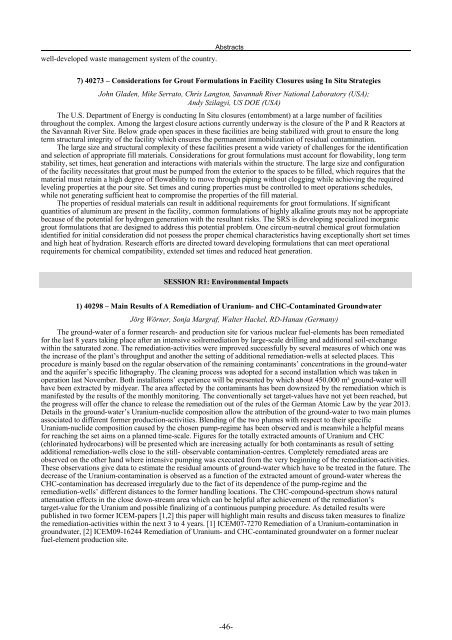ASME Message
ASME Message
ASME Message
Create successful ePaper yourself
Turn your PDF publications into a flip-book with our unique Google optimized e-Paper software.
well-developed waste management system of the country.<br />
Abstracts<br />
7) 40273 – Considerations for Grout Formulations in Facility Closures using In Situ Strategies<br />
John Gladen, Mike Serrato, Chris Langton, Savannah River National Laboratory (USA);<br />
Andy Szilagyi, US DOE (USA)<br />
The U.S. Department of Energy is conducting In Situ closures (entombment) at a large number of facilities<br />
throughout the complex. Among the largest closure actions currently underway is the closure of the P and R Reactors at<br />
the Savannah River Site. Below grade open spaces in these facilities are being stabilized with grout to ensure the long<br />
term structural integrity of the facility which ensures the permanent immobilization of residual contamination.<br />
The large size and structural complexity of these facilities present a wide variety of challenges for the identification<br />
and selection of appropriate fill materials. Considerations for grout formulations must account for flowability, long term<br />
stability, set times, heat generation and interactions with materials within the structure. The large size and configuration<br />
of the facility necessitates that grout must be pumped from the exterior to the spaces to be filled, which requires that the<br />
material must retain a high degree of flowability to move through piping without clogging while achieving the required<br />
leveling properties at the pour site. Set times and curing properties must be controlled to meet operations schedules,<br />
while not generating sufficient heat to compromise the properties of the fill material.<br />
The properties of residual materials can result in additional requirements for grout formulations. If significant<br />
quantities of aluminum are present in the facility, common formulations of highly alkaline grouts may not be appropriate<br />
because of the potential for hydrogen generation with the resultant risks. The SRS is developing specialized inorganic<br />
grout formulations that are designed to address this potential problem. One circum-neutral chemical grout formulation<br />
identified for initial consideration did not possess the proper chemical characteristics having exceptionally short set times<br />
and high heat of hydration. Research efforts are directed toward developing formulations that can meet operational<br />
requirements for chemical compatibility, extended set times and reduced heat generation.<br />
SESSION R1: Environmental Impacts<br />
1) 40298 – Main Results of A Remediation of Uranium- and CHC-Contaminated Groundwater<br />
Jörg Wörner, Sonja Margraf, Walter Hackel, RD-Hanau (Germany)<br />
The ground-water of a former research- and production site for various nuclear fuel-elements has been remediated<br />
for the last 8 years taking place after an intensive soilremediation by large-scale drilling and additional soil-exchange<br />
within the saturated zone. The remediation-activities were improved successfully by several measures of which one was<br />
the increase of the plant’s throughput and another the setting of additional remediation-wells at selected places. This<br />
procedure is mainly based on the regular observation of the remaining contaminants’ concentrations in the ground-water<br />
and the aquifer’s specific lithography. The cleaning process was adopted for a second installation which was taken in<br />
operation last November. Both installations’ experience will be presented by which about 450.000 m³ ground-water will<br />
have been extracted by midyear. The area affected by the contaminants has been downsized by the remediation which is<br />
manifested by the results of the monthly monitoring. The conventionally set target-values have not yet been reached, but<br />
the progress will offer the chance to release the remediation out of the rules of the German Atomic Law by the year 2013.<br />
Details in the ground-water’s Uranium-nuclide composition allow the attribution of the ground-water to two main plumes<br />
associated to different former production-activities. Blending of the two plumes with respect to their specific<br />
Uranium-nuclide composition caused by the chosen pump-regime has been observed and is meanwhile a helpful means<br />
for reaching the set aims on a planned time-scale. Figures for the totally extracted amounts of Uranium and CHC<br />
(chlorinated hydrocarbons) will be presented which are increasing actually for both contaminants as result of setting<br />
additional remediation-wells close to the still- observable contamination-centres. Completely remediated areas are<br />
observed on the other hand where intensive pumping was executed from the very beginning of the remediation-activities.<br />
These observations give data to estimate the residual amounts of ground-water which have to be treated in the future. The<br />
decrease of the Uranium-contamination is observed as a function of the extracted amount of ground-water whereas the<br />
CHC-contamination has decreased irregularly due to the fact of its dependence of the pump-regime and the<br />
remediation-wells’ different distances to the former handling locations. The CHC-compound-spectrum shows natural<br />
attenuation effects in the close down-stream area which can be helpful after achievement of the remediation’s<br />
target-value for the Uranium and possible finalizing of a continuous pumping procedure. As detailed results were<br />
published in two former ICEM-papers [1,2] this paper will highlight main results and discuss taken measures to finalize<br />
the remediation-activities within the next 3 to 4 years. [1] ICEM07-7270 Remediation of a Uranium-contamination in<br />
groundwater, [2] ICEM09-16244 Remediation of Uranium- and CHC-contaminated groundwater on a former nuclear<br />
fuel-element production site.<br />
-46-


